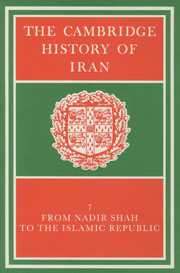8 results in The Cambridge History of Iran

The Cambridge History of Iran
-
- Published online:
- 28 March 2008
- Print publication:
- 14 April 1983

The Cambridge History of Iran
-
- Published online:
- 28 March 2008
- Print publication:
- 06 February 1986

The Cambridge History of Iran
-
- Published online:
- 28 March 2008
- Print publication:
- 01 October 1968

The Cambridge History of Iran
-
- Published online:
- 28 March 2008
- Print publication:
- 06 June 1985

The Cambridge History of Iran
-
- Published online:
- 28 March 2008
- Print publication:
- 10 October 1991

The Cambridge History of Iran
-
- Published online:
- 28 March 2008
- Print publication:
- 26 June 1975

The Cambridge History of Iran
-
- Published online:
- 28 March 2008
- Print publication:
- 01 January 1968

The Cambridge History of Iran
- Seleucid Parthian
-
- Published online:
- 28 March 2008
- Print publication:
- 14 April 1983

